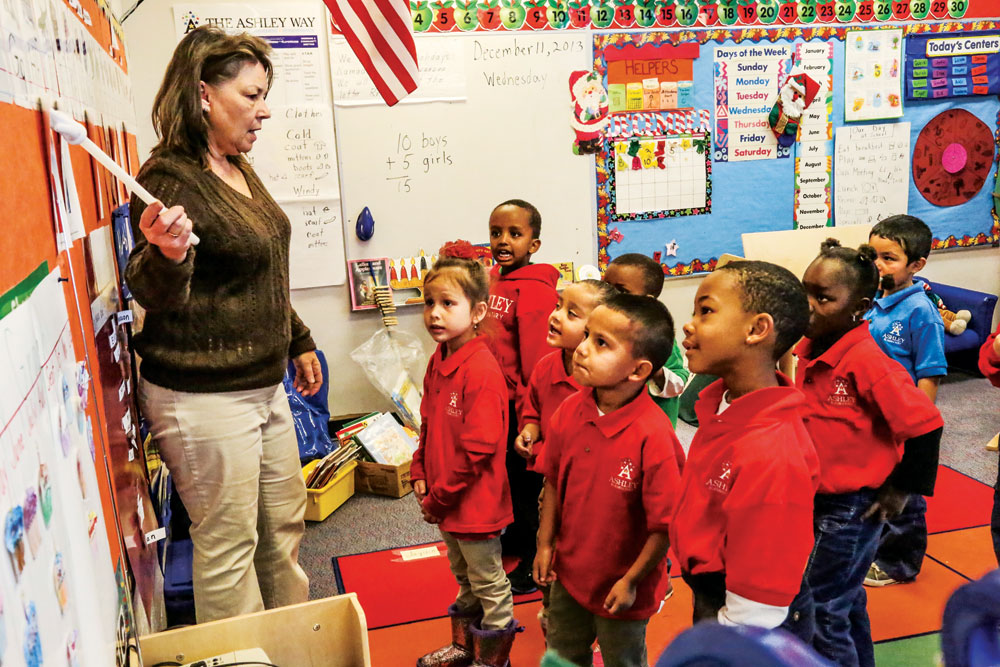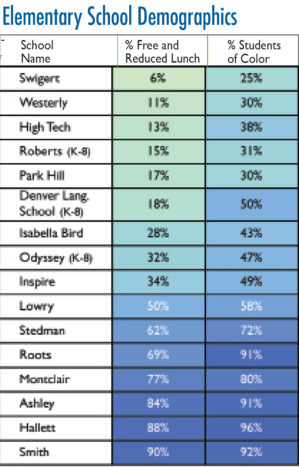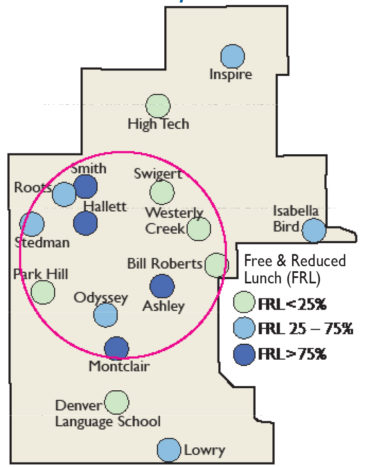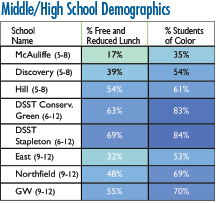
Beginning in Fall 2018-19, Northeast Denver Schools will participate in a plan to make more seats available at high performing schools for students who receive free and reduced lunch (FRL). Above, a Front Porch file photo shows an Ashley classroom. Ashley, where 94 percent of students receive FRL, adjoins the Stapleton neighborhood where most schools have fewer than 15 percent of students receiving FRL.
The figures in the map speak for themselves, but for those who prefer words: segregation persists in Northeast Denver schools, even in 2018. But local educators are stepping up, leading Denver Public Schools to adopt new policies to increase integration at both the elementary and middle school levels, starting with next fall’s classes.
Examining the map, McAuliffe International School principal Kurt Dennis points to Smith Elementary, an elementary school in north Park Hill where 90 percent of the students receive free and reduced lunch (FRL), a proxy for poverty. Then he points to Swigert International School, whose FRL population is only 6 percent.
“This has never been OK, and it’s certainly not appropriate in 2018,” says Dennis. “When you look at the course of history and housing policy and school boundary policy over decades, this is what you end up with. And it’s not OK to have schools within two miles of each other that can look that different.” Dennis believes that now is the time to change that pattern, and he and other local leaders are beginning to discuss the problem and implement new strategies to address inequities.

In NE Denver, some elementary schools in close proximity to each other have dramatically different numbers of FRL students and students of color.
The Problem
High-poverty schools are ones where more than 75 percent of the students receive free and reduced lunch, like the schools noted in dark blue on our map and chart. Low-poverty schools enroll 25 percent or fewer students in that category, like the schools in light blue.
Studies show that, in general, students in high-poverty schools perform worse on measures of academic achievement and have lower graduation rates than those in low-poverty schools. High poverty is often correlated with lower overall school performance, such as in Denver’s School Performance Framework (SPF) ratings.
And all too often, there is an overlap between poverty and race, where students of color disproportionately attend high-poverty schools. The charts included here show those correlations.
At McAuliffe, Dennis finds that the lack of social integration in elementary schools persists into middle school. “Students immediately self-segregate. You walk into a cafeteria on day one and you have black kids at one table and white kids at another,” says Dennis. “If students [of diverse backgrounds] are going to school together at age 4, would that still be the case at age 12?” And

On Jan. 23, (from left) McAuliffe Principal Kurt Dennis, DPS Superintendent Tom Boasberg, Inspire Principal Marisol Enriquez and East High School Principal John Youngquist announce the expansion
of a pilot program to give FRL students more access to high performing schoools.
academically, gaps that pre-date elementary school persist into middle school, says Dennis.
Recent studies show that students of all backgrounds benefit by attending diverse, integrated schools, says Kevin King, an instructional superintendent for elementary schools in the near northeast region. “Some of those outcomes are most prominent in colleges and job sites … students from all races and socioeconomics learn how to embrace differences,” says King. “The emotional intelligence that comes from working in multicultural settings—that’s what employers are looking for.”
One of the elementary schools under King’s supervision, Westerly Creek, is participating in a program to offer more culturally responsive education, understand its equity issues and to close gaps for underserved students. “All schools, all students can benefit from more integrated settings,” says King.
Near-Term Approaches
Local educators are committed to addressing the lack of integration in Northeast Denver, and schools have already begun taking some steps toward improving diversity and inclusion in partnership with DPS.
District-wide, some schools that have 40% FRL rates and lower are participating in prioritizing any open seats (after zone/boundary assignments) for FRL students, although many schools have few, if any, open seats.
One of the new policies that will be implemented is creating “floors”—that is, baseline enrollment requirements—for the percentage of FRL students enrolled at local schools.
Beginning in Fall 2018-19, DPS will institute three new requirements locally:
Implement an FRL floor at all Greater Park Hill/Stapleton Middle Schools, starting with 20% and ramping up to the zone average [about 30%] over 3 years.
Implement an FRL floor at High Tech and Inspire of 25% for kindergarten.
Introduce an FRL priority for all Stapleton zone schools with fewer than a given socioeconomic diversity level after zone students are assigned.

NE DENVER ELEMENTARY SCHOOL LOCATIONS Eleven elementary schools within a three-mile diameter have widely varying populations of students receiving free and reduced lunch (FRL).
These new mandatory floor for FRL students should be fairly easy to achieve without impacting the enrollment of in-zone students in Stapleton and Park Hill, says Brian Eschbacher, the executive director of planning and enrollment services for DPS. For example, High Tech currently has a schoolwide rate of 13 percent FRL, well below the 25 percent floor for next year’s kindergarten. But in a class of 75 kindergarteners, that would only equate to including nine or 10 additional FRL students, noted Eschbacher.
Likewise, at McAuliffe, which currently enrolls about 17 percent FRL students, increasing that figure to 20 percent in a sixth-grade class of 480 means enrolling an additional 14 FRL students. Last year, McAuliffe accepted all in-zone students and had an additional 63 seats available for out-of-zone students, according to Dennis. By 2023, it would mean an additional 187 seats for FRL students.
Leaders at Swigert International are planning to implement a policy similar to that of High Tech and Inspire for its 2019 kindergarten class, which will increase in size to accommodate a new FRL floor and neighborhood demand for seats.

Although NE Middle and high schools are more diverse than elementary, there is still room for improvement.
East High School has already begun prioritizing FRL students for open spots after zone students have been enrolled, which has helped it become more diverse. East’s goal is to reach 35 percent FRL enrollment. At 32 percent FRL and 53 percent students of color, East lags behind Northfield and George Washington in its diversity.
Long-Term Approaches to the Problem
DPS has been working with a large committee of stakeholders through the Strengthening Neighborhoods Initiative (SNI). Over the course of many months, teachers, parents, students and community members have been meeting to discuss how to increase integration and inclusion at schools across the district.
What has emerged from SNI are multiple recommendations and plans to begin implementing them. Overarching recommendations to increase integration include setting specific goals, supporting schools with resources, coordinating with the city and expanding community engagement, says Susana Cordova, deputy superintendent of DPS.

McAuliffe principal Kurt Dennis, pictured here in a Front Porch file photo, asks the question, “If students [of diverse backgrounds] are going to school together at age 4, would (self-segregation in the cafeteria] still be the case at age 12?”
SNI co-chair and community member Diana Romero-Campbell described specific goals that have emerged from the SNI: increasing access, focusing on equity, and improving design and sustainability. “There are so many benefits [to integration],” says Romero-Campbell. “It really does provide for not only the students but the teachers and the whole community to live not in a bubble but in the reality of what people will experience throughout their life.”
School leaders agree that ongoing conversations need to occur, even if they’re what Romero-Campbell calls “messy.” Implementation of further integration measures in Northeast Denver and beyond will be guided by the community. “It’s going to look different at different schools…We don’t have one model,” says Superintendent Tom Boasberg. “It’s about ensuring a strong community voice about what’s right for that school community.”
To learn more about the Strengthening Neighborhoods Initiative, see www.dspk12.org/neighborhoods. Watch for opportunities at your local schools to participate in the conversation.




It seems to me like a race to mandate and become “equally diverse” in schools, rather than focus on who wants to go where, or maintain a specific type of curriculum, OR simply make our schools better everywhere . Typically kids from a neighborhood like to go to school with other kids from their neighborhood- regardless of their income level or race/color. Forcing our kids to go to school elsewhere in order to “level the playing field” so higher performing schools feel like they are giving it a “good try” seems like the wrong reason. Seems to me like white people trying to save face, not kids.
If the Stapleton/Park Hill boundary has an average of 30% FRL, FRL middle school families must not be putting the highest performing school (McAuliffe) as their 1st choice at the same rate as non-FRL families. Otherwise it would not be 39% at DDS and 17% at McAuliffe, unless the lottery is rigged. There were even out-of-boundary seats open at McAuliffe last year, so everyone in-boundary got in that wanted to. DPS should start by fixing the reasons those families don’t choose McAuliffe instead of forcing their kids to attend a school they don’t want to.
As if you somehow care more for your children than anyone else because you have money. It does start at home, so how much time are you spending with your kids? I’d wager that like most rich white people, poor black and hispanic people spend more time raising their children than you. And they are working just as hard as you if not harder for their children, the only difference is the roll of the Socioeconomic die.
Enjoy your privilege while you have it….
So what’s the point in moving to a good neighborhood with good schools? And spending a lot of money to do so? Money that I worked hard for, that was absolutely not handed to me, so that I could give my children a good life and education. You’re just going to bus kids in from impoverished areas where parents don’t care or don’t have time to care about their kids’ behavior and/or success (that’s a FACT, so don’t give me some “you’re prejudiced” response). It won’t necessarily bring those kids up, but it will probably bring the school down (even if marginally). If parents don’t/can’t care and be involved, bussing their kids to a better school is useless. It starts at home. But let’s all live in la la land and pretend that what should happen is what will happen.
Mr/Ms JWC,
A few responses to your point, our organization A+ Colorado apluscolorado.org will be issuing a report on this topic next week-
1) Public schools are supposed to be public (open and supporting all students), just because you have a more expensive house, you should not have greater access to better schools, though in most places there is a connection because of housing/zoning patterns and school quality.
2) There is not a direct relationship (though there is a strong correlation) between academic outcomes and poverty. Some of the best schools in CO for every group of students are schools that serve diverse populations of students, e.g. DSST, Odyssey, DCIS etc. Some of the best high schools for getting students into the best most selective colleges are diverse urban schools, DSST, East, GW etc, not suburban less diverse high schools.
3) The research is pretty clear that if schools are focused on serving all students and the school has a diverse population that all students will do better, rich, poor, while, students of color, etc
4) Our most successful graduates will be those that have a rich set of academic skills/habits/knowledge and a host of leadership/communication/people skills. Young adults that have broad cultural understanding of others and can work with people of all backgrounds will be far better off for career success than others.
5) Low-income parents care no less or more than rich parents about their kids, you might want to spend some time with Together Colorado or Padres Unidos to get a sense of their commitment to their kids.
JWC, would you be open to volunteering at, or even touring a school with higher rates of FRL? I wonder if you might find the kids are actually pretty great. It sounds like you fear kids from less resourced backgrounds being around your kids. But, before you oppose the district creating opportunities for kids who could use more breaks, maybe try to see if there really is anything to fear. As others have pointed out, the data suggests that integrated schools help all kids. By the way, it doesn’t sound like kids would be bussed in, it sounds like the parents would have to select the schools and find a way to make it work. This belies the assertion that these parents don’t care. In my experience, most parents care a lot, up and down the income distribution.